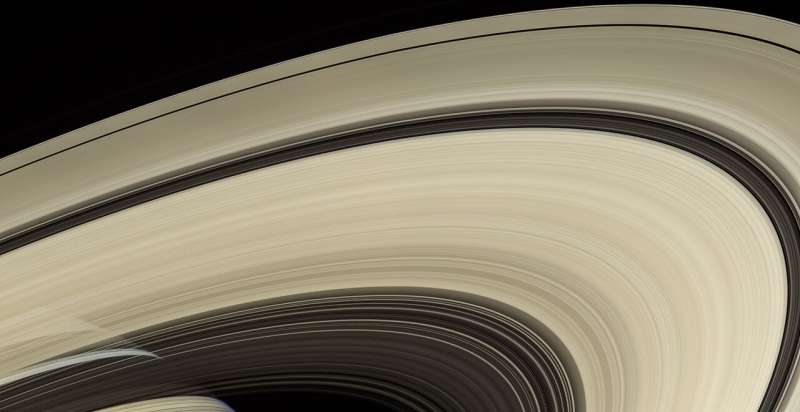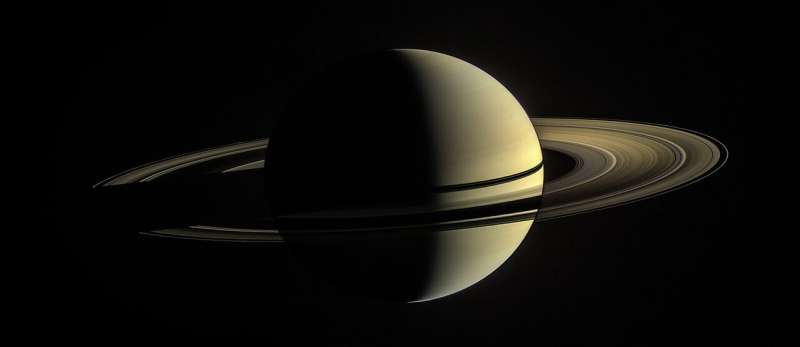Researchers say the age of Saturn's rings is difficult to determine

A team of researchers has reignited the debate about the age of Saturn's rings with a study that dates the rings as most likely to have formed early in the Solar System.
In a paper published today in Nature Astronomy and presented at the EPSC-DPS Joint Meeting 2019 in Geneva, the authors suggest that processes that preferentially eject dusty and organic material out of Saturn's rings could make the rings look much younger than they actually are.
Cassini's dive through the rings during the mission's Grand Finale in 2017 provided data that was interpreted as evidence that Saturn's rings formed just a few tens of millions of years ago, around the time that dinosaurs walked the Earth. Gravity measurements taken during the dive gave a more accurate estimate of the mass of the rings, which are made up of more than 95 percent water ice and less than 5 percent rocks, organic materials and metals. The mass estimate was then used to work out how long the pristine ice of the rings would need to be exposed to dust and micrometeorites to reach the level of other "pollutants" that we see today.
For many, this resolved the mystery of the age of the rings. However, Aurelien Crida, lead author of the new study, believes that the debate is not yet settled.
"We can't directly measure the age of Saturn's rings like the rings on a tree stump, so we have to deduce their age from other properties like mass and chemical composition. Recent studies have made assumptions that the dust flow is constant, the mass of the rings is constant, and that the rings retain all the pollution material that they receive. However, there is still a lot of uncertainty about all these points and, when taken with other results from the Cassini mission, we believe that there is a strong case that the rings are much, much older," said Dr. Crida, of the Observatoire de la Côte d"Azur, CNRS.

Crida and colleagues argue that the mass measured during the Cassini mission finale is in extraordinarily good agreement with models of the dynamical evolution of massive rings dating back to the primordial Solar System.
The rings are made of particles and blocks ranging in size from meters down to micrometers. Viscous interactions between the blocks cause the rings to spread out and carry material away like a conveyor-belt. This leads to mass loss from the innermost edge, where particles fall into the planet, and from the outer edge, where material crosses the outer boundary into a region where moonlets and satellites start to form.
More massive rings spread more rapidly and lose mass faster. The models show that whatever the initial mass of the rings, there is a tendency for the rings to converge on a mass measured by Cassini after around 4 billion years, matching the timescale of the formation of the solar system.
"From our present understanding of the viscosity of the rings, the mass measured during the Cassini Grand Finale would be the natural product of several billion years of evolution, which is appealing. Admittedly, nothing forbids the rings from having been formed very recently with this precise mass and having barely evolved since. However, that would be quite a coincidence," said Dr. Crida.
Co-author Hsiang-Wen Hsu was part of a team that announced results in October 2018 from Cassini's Cosmic Dust Analyzer, which showed 600 kilograms of silicate grains fall on Saturn from the rings every second. Other studies using data from the Cassini Ion and Neutral Mass Spectrometer have shown the presence of organic molecules in Saturn's upper atmosphere that are thought to derive from the rings.
Dr. Hsu, of the Laboratory for Space and Atmospheric Physics at Boulder, Colorado, said: "These results suggest that the rings are 'cleaning' themselves of pollutants. The nature of this potential ring-cleaning process is still mysterious. However, our study shows that the exposure age is not necessarily linked to the formation age, thus the rings may appear artificially young."
More information: Aurélien Crida et al. Are Saturn's rings actually young?, Nature Astronomy (2019). DOI: 10.1038/s41550-019-0876-y Aurélien Crida et al. Are Saturn's rings actually young?, Nature Astronomy (2019). DOI: 10.1038/s41550-019-0876-y
Journal information: Nature Astronomy
Provided by EuroPlanet Society





















